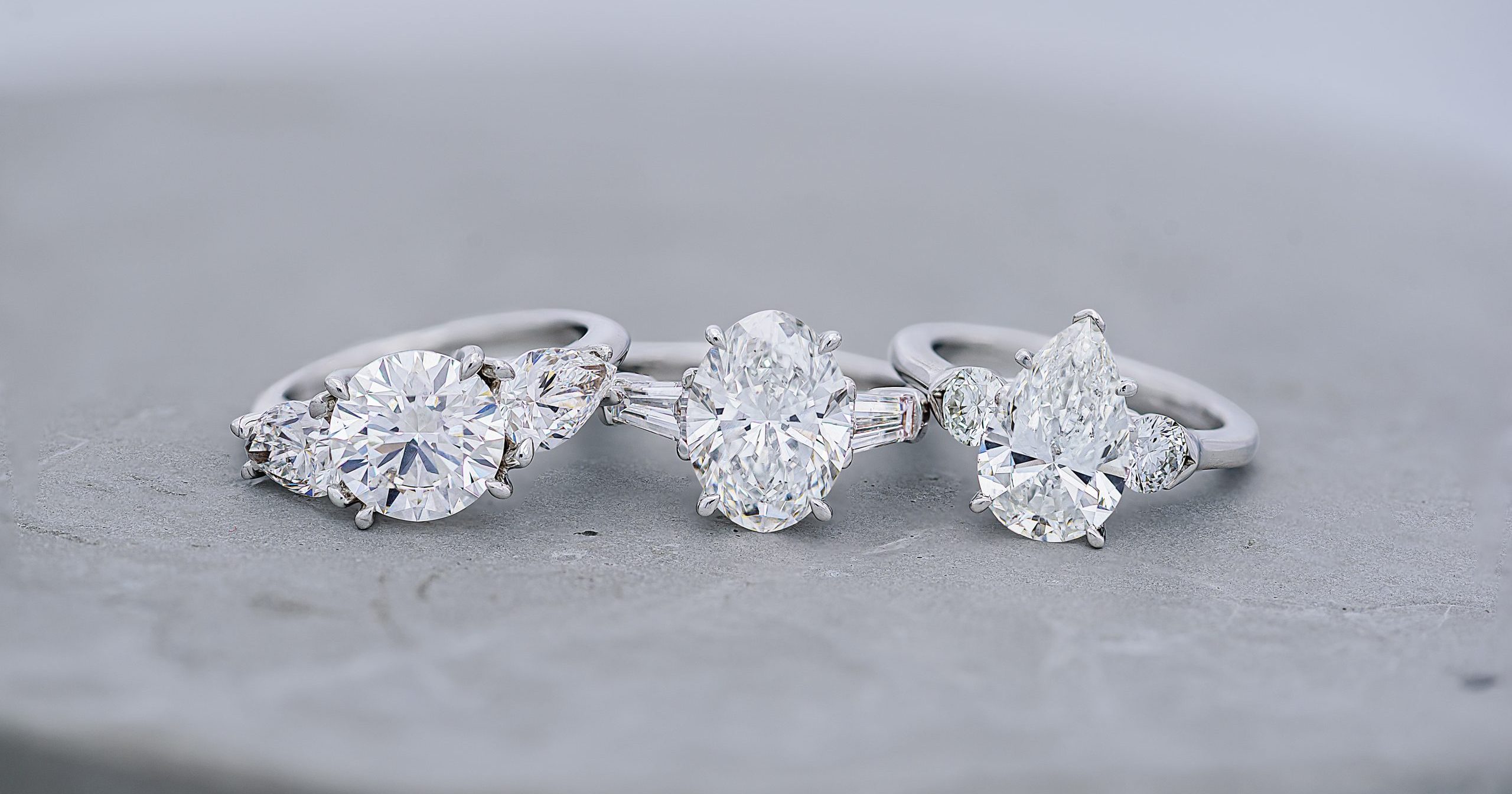Before we ever even ask how the big question was popped, we want to gush over the engagement ring. Did you choose a cushion cut? Emerald? How many carats is it? If the answer to the last question seems too impressive, we clear our throats and pry, “Is it real?” While it is a social faux pas to ask, future bridesmaids still want to know. In years past, the question may have been referring to the difference between an earth-made diamond and cubic zirconium or other stimulants, but now many brides wonder where lab-grown diamonds fall on the spectrum.
Why Lab-Grown Diamonds Are Winning Hearts
- Your wallet will thank you. The average cost per carat is 35-40% less than that of natural diamonds.
- You can obtain the same cut, color, clarity, and carat in a lab-grown diamond as you can with natural diamonds, if not better.
- They look and feel just like natural-made diamonds.
- 60% of lab-grown sales are bridal in nature.
- Lab-grown diamonds are sustainable. While natural diamonds are rare and unique, mining them is hard on the environment, including soil erosion, deforestation, and ecosystem destruction.
- As of 2021, man-made diamonds make up 7% of the specialty diamond jewelry market, up from 3% in 2020.

What are Lab-Grown Diamonds?
First of all, let us set the record straight: lab-created diamonds are real diamonds!
To the naked eye, there is no difference between a lab cultured diamond and one that was mined from below ground. Both are made of actual carbon atoms arranged in the characteristic diamond crystal structure. However, cultured diamonds tend to have fewer blemishes than mined ones because they can be created in controlled conditions.
Lab-grown diamonds, also known as man-made or cultivated diamonds, are created in a laboratory by one of two methods: High Pressure High Temperature (HPHT) or Chemical Vapor Deposition (CVD). On the Mohs scale, lab-grown diamonds have a hardness of 10, and their refractive index is 2.417—2.419.
Gems that look like diamonds but aren’t actually diamonds are called stimulants. The most popular are cubic zirconia and synthetic moissanite, and they have very different chemical and physical properties that allow trained gemologists to identify them easily.

According to DiamondBuzz:
“Lab-created diamonds are identical to natural ones in terms of crystal structure, chemical composition, appearance, and physical properties. The difference between natural and lab-grown diamonds is the way they were made and their price. No wonder synthetic diamonds are more affordable than natural ones because the latter are rare and hard to mine. In fact, by buying a lab-grown diamond, you can save up to 40%.”
To understand the difference between natural-made diamonds and lab-grown diamonds, let’s take a closer look at how a “girl’s best friend” is created.
Understanding the History of Diamonds
Scientists believe that diamonds are actually older than plants. In order for us to understand how science is redefining the diamond formation process, we first have to understand what has created these precious gems for centuries before us.
Diamonds are the only gem made from a single element. They are 99.5% carbon and are formed at least 100 miles beneath the earth’s surface. The high temperature combined with the weight of 100 miles or more of earth combine to create the perfect storm, forming one of the world’s strongest gems.
To save you the trouble of searching for a drill that goes that deep into the earth—it doesn’t exist. Diamonds rise to the earth’s surface from mini-volcanoes that erupt deep in the earth’s mantle.

According to Diamond Pro, “Deep-source volcanoes start three times as deep as typical volcanoes. The high levels of magnesium and carbon dioxide force the magma to the surface, resulting in a violent eruption. Diamonds are typically elevated through kimberlite pipes, which form a bowl-shaped pockmark in the Earth after an eruption. When mining these kimberlite sites, precious and semi-precious gemstones like garnet and peridot are also found among diamonds.”
It’s no surprise diamonds sport such high price tags when you understand the creation process. Since the earth took millions to possibly billions of years to form diamonds, what process do diamond labs use to form these beautiful gems?
How a Lab-Grown Diamond is Formed
Believe it or not, laboratory diamonds are not a new thing. The practice started in the 1950s, but these diamonds were too small for jewelry. Larger gems weren’t produced until the 1990s and then weren’t made available on the market until the 2010s.
There are two methods to form diamonds in a laboratory, and you may notice they both mimic the circumstances similar to the process that creates naturally-formed diamonds.
- High Pressure, High Temperature (HPHT)
- Chemical Vapor Deposition (CVD)

High Pressure, High Temperature (HPHT)
According to the Gemological Institute of America, Inc., “HPHT is one of the primary methods used to grow diamonds in a lab. This diamond growth process subjects carbon to extreme temperatures and pressures and is meant to replicate the extreme heat and pressure conditions deep within the earth where natural diamonds form.”
A diamond seed is placed in a specifically designed press or capsule. The growth chamber is heated to 1300-1600 °C with pressures above 870,000 pounds per square inch.
Within the capsule, a carbon starting material, such as graphite, dissolves in a molten flux consisting of metals such as iron (Fe), nickel (Ni), or cobalt (Co), which lowers the temperature and pressure needed for diamond growth. The carbon material then migrates through the flux towards the cooler diamond seed and crystallizes on it to form a synthetic diamond crystal.
Finally, carbon atoms precipitate on a small diamond seed crystal, and a synthetic diamond begins to grow. This process can take a few days to a number of weeks, depending on the size of the diamond. The lab-grown crystal is then cut and polished by a diamond cutter.
Chemical Vapor Deposition (CVD)
The second method of laboratory diamond creation is CVD. Diamonds grow from a hydrocarbon gas mixture subjected to moderate pressures and temperatures in a vacuum chamber.
With this method, diamond seed crystals are placed in a diamond growth chamber. If it sounds like a magical process, that’s because it is!
The chamber is filled with carbon-containing gas and heated to about 900-1200°C. A microwave beam causes carbon to precipitate out of a plasma cloud and deposit onto a seed crystal. Magic, right?
The diamonds are removed every few days to have the top surface polished to remove any non-diamond carbon before being put back in to grow. Each batch of diamonds may require several stop/start cycles, and the entire growth process can take three or four weeks. After the synthetic diamond crystals are removed, they are ready to be cut and polished into the final product.

Lab-Grown: A Girl’s Best Friend
Whether diamonds travel the journey of an erupting volcano or the brilliance of weeks of pressure in a diamond growth chamber, both types of diamonds are real and indistinguishable to the naked eye. The truth is that even gemologists have an incredibly difficult time deciphering between earth-made diamonds and lab-created ones.
In 2021, the price of natural diamonds went up between 15% to 30%. During the same period, the price of lab-grown diamonds declined between 20%-40%.
So, if you’re aiming for that Hallmark engagement scenario with the perfect diamond ring to match, the only one who will be able to tell whether it’s natural or lab-grown is your wallet!




